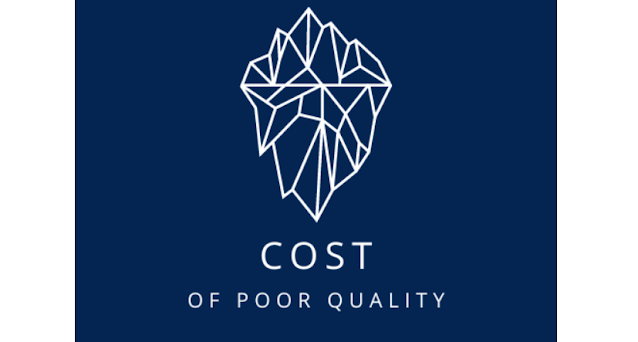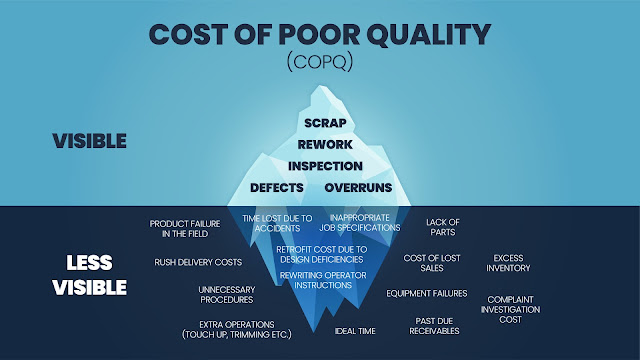Mitigating COPQ for a Thriving Business FutureMitigating COPQ for a Thriving Business Future
- February 6, 2024
- Posted by: bhushanpungliya
- Categories: Blog, Consulting

COPQ, or Cost of Poor Quality, plays a critical role in business by quantifying the financial impact of poor quality products or services across various operational areas. It encompasses both tangible and intangible costs incurred due to defects, errors, inefficiencies, and deviations from quality standards throughout the production or service delivery process.

COPQ iceberg is a concept used in quality management to illustrate the visible and hidden costs associated with poor quality in products or services. It’s called an iceberg because, similar to an iceberg where only a small portion is visible above the water while the bulk lies beneath, the costs of poor quality have visible aspects and underlying, often hidden, components.

Impact on Indian Business:
The visible costs include things like:
- Scrap and Rework: Costs incurred due to defective products that must be scrapped or reworked to meet quality standards.
- Warranty Claims: Expenses related to addressing warranty claims or customer complaints due to product failures or issues.
- Customer Returns: Costs involved in handling and processing returned products due to quality issues.
- Complaint Management: Expenses associated with addressing customer complaints, including customer service efforts, investigations, and resolution.
The hidden costs, lying beneath the surface, include:
- Lost Customers: When poor quality leads to dissatisfied customers who take their business elsewhere, the loss of future revenue isn’t always immediately quantifiable.
- Reputation Damage: Poor quality can tarnish a company’s reputation, leading to decreased brand value and potential long-term impacts on sales and market position.
- Reduced Employee Morale: Continuously dealing with quality issues can demoralize employees, affecting their productivity and engagement.
- Process Inefficiencies: Inefficient processes that lead to poor quality might not have direct cost attributions but can have long-term financial impacts due to wasted time and resources.
- Competitive Disadvantage: In highly competitive markets, poor quality can lead to a loss of competitiveness against both domestic and international competitors.
- Customer Dissatisfaction: Indian consumers, like any others, have increasing expectations regarding product and service quality. Failure to meet these expectations can result in dissatisfied customers and loss of market share.
- Cost Escalation: COPQ can lead to increased operational costs due to rework, warranty claims, and customer support efforts.
- Global Reputation: For businesses eyeing global markets, poor quality can harm India’s reputation as a provider of quality products and services, impacting export potential.
- Quality Management Systems (QMS): Implement robust QMS frameworks like Six Sigma, Total Quality Management (TQM), or Lean Management. These systems focus on continuous improvement, reducing defects, and enhancing overall quality.
- Employee Training and Engagement: Invest in training programs to enhance employee skills and awareness regarding quality standards. Engage employees in quality improvement initiatives to encourage ownership and innovation in identifying and resolving quality issues.
- Supplier Quality Management: Ensure suppliers meet quality standards to prevent incoming material defects. Collaborate with suppliers to improve quality at the source, reducing the chances of defects in products or services.
- Data-Driven Decision Making: Use data analytics to identify trends, root causes of quality issues, and areas for improvement. This helps in making informed decisions to address underlying problems.
- Continuous Improvement Culture: Foster a culture of continuous improvement where employees are encouraged to suggest and implement quality enhancements. Recognize and reward innovative quality improvements.
- Customer Feedback and Satisfaction: Regularly gather customer feedback to understand their expectations and experiences. Use this information to improve products/services and address any recurring quality issues promptly.
- Process Optimization: Streamline and optimize processes to reduce errors, defects, and inefficiencies. Use tools like process mapping and value stream analysis to identify and eliminate waste.
- Risk Management: Implement proactive risk management strategies to anticipate and mitigate potential quality issues before they impact products or services.
- Quality Audits and Inspections: Conduct regular quality audits and inspections to ensure compliance with quality standards. Identify areas of improvement and take corrective actions promptly.
- Investment in Technology: Utilize technology, automation, and quality control tools to improve accuracy, reduce defects, and enhance quality assurance processes.
